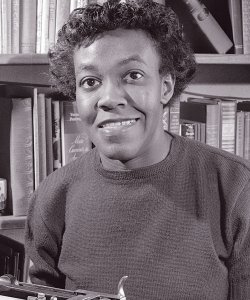A Quiet Passion, Viet Thanh Nguyen’s Early Writing Days, and More
Kathryn Schulz chronicles literature’s obsession with the Arctic; the case for hate-reading; an anesthesiologist’s take on poetry; and other news.
Jump to navigation Skip to content
Kathryn Schulz chronicles literature’s obsession with the Arctic; the case for hate-reading; an anesthesiologist’s take on poetry; and other news.
“A single book can be a community.” In this video, Craig Morgan Teicher responds to the question, “What is your ideal reading experience?” His third poetry collection, The Trembling Answers (BOA Editions, 2017), is featured in Page One in the May/June 2017 issue of Poets & Writers Magazine.
“I am a wooly mammoth stuffed into a cab. I bear / the long silence of my extinction through the rearview.” Samiya Bashir, whose poetry collection Field Theories (Nightboat Books, 2017) is featured in Page One in the May/June 2017 issue of Poets & Writers Magazine, reads her poem “Paleontology.”
“Poetry survives the errors of its beliefs.” In this video, Jon Baskin, editor of the Point, moderates a panel exploring the purpose of poetry with Don Share, Srikanth Reddy, Lamar Jorden, and Kush Thompson.

Poet, playwright, and novelist Angela Jackson explores the teenage years of Pulitzer Prize–winning poet Gwendolyn Brooks.

The new executive director of the Cave Canem Foundation talks about her history with the organization, her vision for the future, and the role of poetry in a hostile political climate.

Alex Dimitrov takes us through five journals that first published poems appearing in his new book, Together and by Ourselves.
“It’s important to be proud of who you are, as a Hmong person, to know your history, to know your roots, because that’s what will really empower you to speak up for your people...” Mai Der Vang, recipient of the 2016 Walt Whitman Award and author of the debut poetry collection, Afterland (Graywolf Press, 2017), speaks about her family’s experience as Hmong refugees in America.
Last month, Crayola announced the retirement of one of their yellow crayon colors, Dandelion, which will soon be replaced by a blue crayon. Since Binney & Smith first began producing Crayola crayons in 1903, many colors have been cycled in and out. Some colors have remained the same shade but changed names over the years, such as Peach, which was previously named Flesh Tint, Flesh, and Pink Beige. Read more about the history of Crayola crayon colors, and write a poem inspired by some of the names you find most evocative, perhaps finding thematic potential in how the types of names have evolved over the years.
Tyehimba Jess reads his poem “Another Man Done” for the Migration Series Poetry Suite, a collection of poems commissioned by the Museum of Modern Art in response to the exhibition “One-Way Ticket: Jacob Lawrence’s Migration Series and Other Visions of the Great Movement North.” Jess won the 2017 Pulitzer Prize in poetry for his collection Olio (Wave Books, 2016).